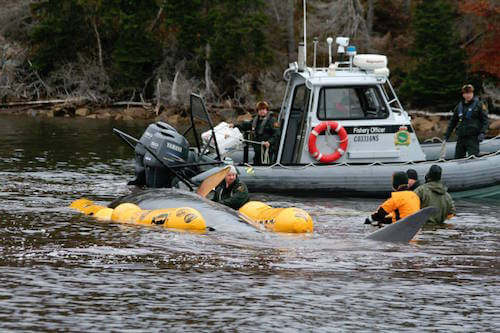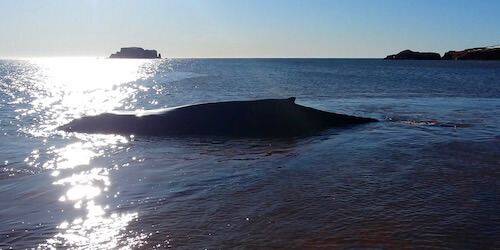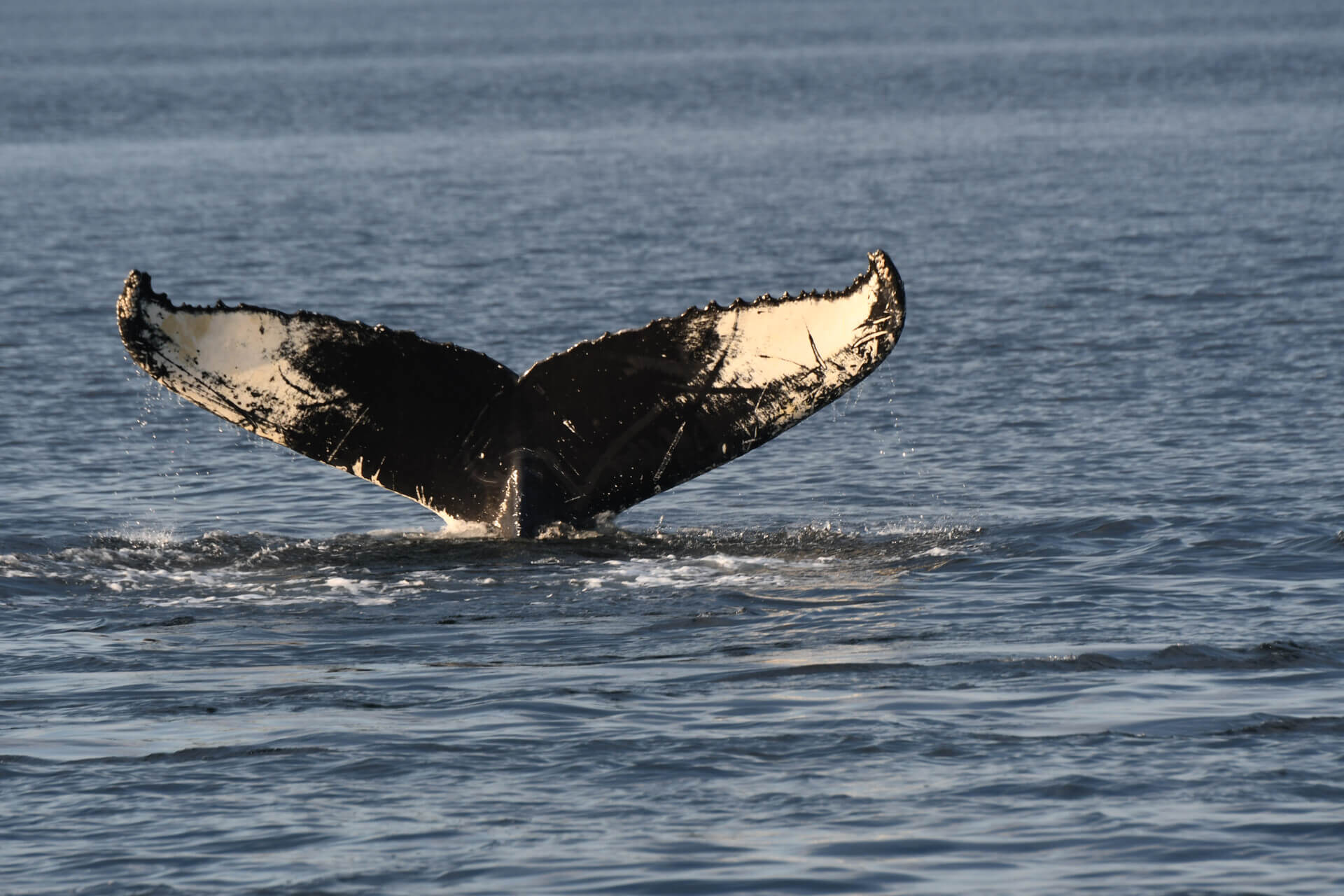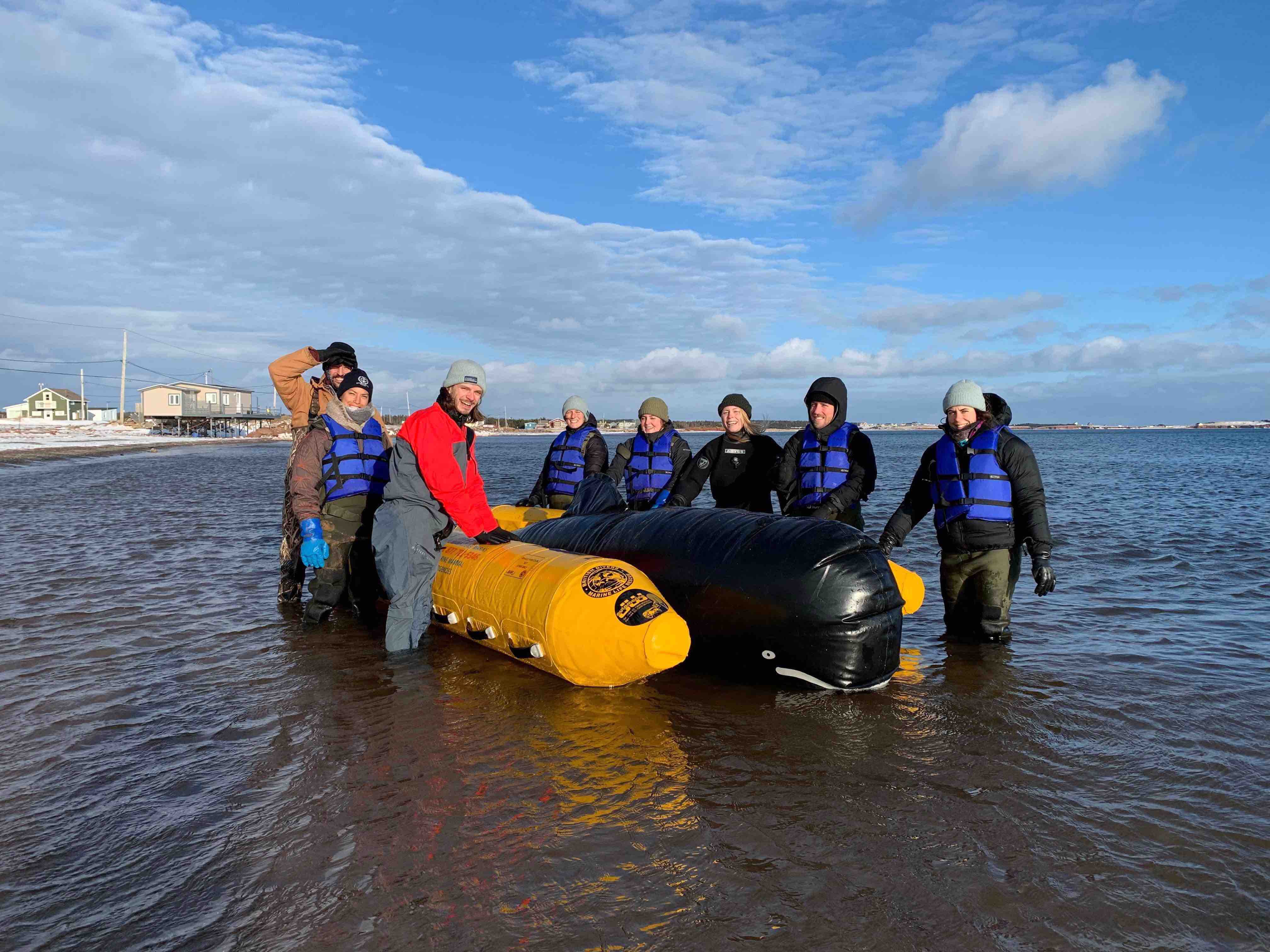On Sunday, March 25, the Quebec Marine Mammal Emergency Response Network received a call concerning a beached humpback whale in the surf at Étang-du-Nord in the Magdalen Islands. The whale died following its stranding on Sunday evening. A necropsy was conducted on the carcass on Wednesday, March 28, 2018.
This incident has raised many questions. Whales Online, in collaboration with Marine Mammal Emergencies and its partners, offers a few responses.
Event recap:
-
- Sunday, March 25: the whale is found stranded alive on the beach of Etang-du-Nord and reported in the afternoon to 1-877-7baleine. The animal is thin and its chances of survival are considered nil, even if it is pushed back into the sea. The whale did not survive its stranding.
- Monday, March 26: the small humpback whale carcass is “naturally” secured and remains stationary approximately 10 metres from shore. Fisheries and Oceans Canada (DFO) assesses the feasibility of documenting the carcass and determining how comprehensive such documentation will be, based on available resources.
- Tuesday, March 27: Authorizations are received and the logistics are sorted out to conduct a necropsy of the whale. Canadian Wildlife Health Cooperative (CWHC) veterinarians are en route to the archipelago, Marine Mammal Emergencies volunteers are being mobilized and DFO, in collaboration with Lavages Industriels Vigneau, is coordinating transport of the whale to the site where the carcass will be studied.
- Wednesday, March 28: the carcass is deposited in the morning in a field in Havre-aux-Maisons, where the whale will be buried following the necropsy. A team of four veterinarians, one technician and eight volunteers participate in a complete examination of the animal, an operation that lasts about five hours.
Q: Why did the whale become stranded?
Initial images of the humpback revealed a very thin and visibly unhealthy whale, but with no evidence of entanglement or obvious injury. It is reasonable to believe that its stranding might be a consequence of its poor state of health. It is possible that this whale, weakened by its poor condition, ventured too close to the coast.
Q: Could the man in the video have saved it?
This whale measured nearly 9 metres long and weighed approximately 7 tonnes. It is impossible to move an animal of this size relying on manpower alone.
It is also important to mention that an intervention such as the one filmed on Sunday is extremely perilous. Although the individual had good intentions, the risks of coming into contact with a distressed whale are very high. These giants are massive and when they struggle, they can inflict wounds that can prove fatal. Combined with crashing waves, sudden movements of the animal’s tail, head or fins can strike and knock a person off balance, who could end up in the frigid water, on top of or underneath the struggling whale: a scenario with potentially catastrophic consequences.
This is why Sureté du Québec was called to the scene by Marine Mammal Emergencies, which feared the worst.
Interventions with marine mammals should be carried out by experts who have the appropriate equipment and authorization to do so. Specialized equipment is needed to move such a giant: floating pontoon (a sort of stretcher with air bladders on each side), specialized straps, machinery, boats that can be manoeuvred in shallow water, etc.
It should be noted that it would be dangerous to drag a whale by its tail; doing so could harm it even more or result in the dislocation of its spinal column, thus further aggravating the situation or even having fatal consequences.
Q: Why was the whale not pushed back out to sea?
From the moment the photos were received and witnesses described the situation to the Marine Mammal Emergencies call centre, specialists from the Marine Animal Response Society (MARS)were contacted to see what options were available. Thanks to the multiple cases that it has handled in the Maritimes, the MARS team has developed considerable expertise with live stranded cetaceans.
This was the second time the MARS team had to deal with a live stranded humpback. In the first case, the animal died before any response could be done. However, in November 2013 in Cape Breton, Nova Scotia, a juvenile fin whale was moved using floating pontoons. The outcome of this operation is unknown, however, as is generally the case for large cetaceans that are relocated.
After assessing the animal’s condition and evaluating its chances of surviving an intervention, Canadian Wildlife Health Cooperative (CWHC) veterinary advisors, DFO scientists and the MARS team were unanimous: this whale would not survive even if it were moved out to sea. Being so thin, and thus undernourished and weak, it probably would not have survived the relocation and even if it had, it would have likely perished in the next few days, whether at sea or by becoming stranded on another beach.
This whale was therefore not a candidate for a rescue.
Q: Why was it not euthanized?
Euthanasia was discussed, but this option was not chosen for this whale because its condition was so critical that experts felt that it would die before they could reach the scene.
Indeed, euthanizing large cetaceans is a delicate undertaking, and can only be carried out by experts since it requires handling and administering large quantities of veterinary drugs that are potentially dangerous for those involved. Risks are also important for anyone involved in sampling and necropsy, if these are still possible. Considering that the experts authorized to carry out such an intervention are not based in the Magdalen Islands, the logistics would have been too complex and the wait, too long.
A stranded whale of this size does not usually survive for very long on account of its weight, which compresses its ribcage. If, however, the whale had survived its first night following the stranding, the euthanasia scenario would most likely have been initiated.
Q: Could it have been carried out by the high tide?
The difference between high tide and low tide in the islands at the time of the incident was 0.1 m. It was extremely unlikely that the high tide would have helped the whale float out to sea again and regain its freedom. There are numerous shoals around the islands and the tides in this portion of the Gulf are generally weak, factors that increase the complexity of the situation.
Q: Might the whale have ingested plastic?
Stomach content analysis is part of the necropsy process. CWHC veterinarian Stéphane Lair, when asked the question, explained that the digestive tract was empty and that there was no evidence of recent ingestion of any substance whatsoever..
Q: What is the role of Marine Mammal Emergencies (UMM) in these situations?
UMM is first and foremost a 24/7 call centre (1-877-7baleine), which handles calls from citizens (between 400 and 500 calls/year) who discover a dead or struggling marine mammal on the shores of the St. Lawrence River in Quebec.
In each situation, the call centre team, in collaboration with partners specializing in marine mammals of Quebec and the Atlantic region, analyzes the situation in order to decide on the best response strategy.
This analysis takes into account a multitude of factors:
-
- Species involved and status thereof (species at risk or not);
- State of the animal;
- Welfare of the animal;
- Is the animal’s situation related to a human cause or a natural cause?
- Availability of expert teams for the sector in which the incident has occurred;
- Safety of individuals involved and the general public;
- Logistical aspects;
- Available material resources; and
- Cost of the response efforts.
Once the analysis has been completed and experts have been consulted, an action plan is fleshed out as quickly as possible.
In the case of live stranded animals, there are several possible intervention options. A “rescue” operation is not systematically deployed and it may be decided to let nature take its course. Many whales also die of natural causes (old age, disease, parasites) and cannot be helped. This is part of life.
UMM strives to collect and document scientific data from each situation. Notably, this process helps to inform and better manage the analysis of future incidents.
UMM also acts as a coordinator for various actions, consulting experts, rallying researchers around the table, coordinating the deployment of volunteer teams in the field, and forging relationships with witnesses and information providers.
Outreach and awareness-raising is done whenever a report is received, whether directly over the phone, on the many digital platforms (whalewatch.org, social networks) or by participating in interviews with the media.
Q: Is the whale known to researchers?
The Mingan Island Cetacean Study (MICS), which oversees the catalogue of humpback whales identified in the St. Lawrence, analyzed the initial photos, which were taken while the specimen was still on the beach.
Initial results suggest that this whale is not known to researchers and that it has not been identified in the past.
Q: Can a correlation be made between this incident and the right whale mortalities of 2017?
Analysis of right whale carcasses in 2017 revealed that in 6 out of 12 carcasses, the deaths were attributable to entanglement in fishing gear or collisions with ships.
In the case of the humpback in the Magdalen Islands, there was no evidence of recent trauma or entanglement.
This case is unrelated to that of the right whales.
What was mentioned in discussions, however, was an event involving Atlantic humpback whales that is currently being carefully examined by researchers. Since last April, US federal authorities have been investigating the “unusually high” number of mortalities of this species on the east coast of the United States, the causes of which remain partially undetermined. NOAA explains that it has observed a significant uptick in the number of annual humpback mortalities since January 1, 2016 and a continuation of this phenomenon in 2017, bringing to 41 the number of these cetaceans found dead to date on the US east coast between Maine to North Carolina.
Additionally, a young female specimen in a similar state was found in Godbout on the North Shore in May 2017. Is this the precursor of a new problem in the waters of the St. Lawrence? Is there a scarcity of prey? The question was raised by scientists.
Q: When will it be possible to obtain the results of the necropsy?
A preliminary report will be published within the next 2 to 3 weeks by the Faculty of Veterinary Medicine of the Université de Montréal, and subsequently made available by the Quebec Marine Mammal Emergency Response Network.
The final report will not be released until the results of the lab analyses are known, which is expected in approximately four months.
Initial findings made by Stéphane Lair the day of the necropsy are that the whale, a young female measuring 8.8 m long, was in a very poor state and showed sub-optimal fat levels. Presumed cause of death: this juvenile (in post-weaning stage) died of starvation.








